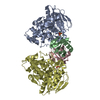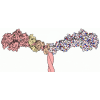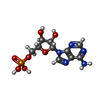[English] 日本語
 Yorodumi
Yorodumi- PDB-8jo3: Cryo-EM structure of a Legionella effector complexed with actin a... -
+ Open data
Open data
- Basic information
Basic information
| Entry | Database: PDB / ID: 8jo3 | |||||||||||||||
|---|---|---|---|---|---|---|---|---|---|---|---|---|---|---|---|---|
| Title | Cryo-EM structure of a Legionella effector complexed with actin and AMP | |||||||||||||||
 Components Components |
| |||||||||||||||
 Keywords Keywords | TOXIN / AMPylation | |||||||||||||||
| Function / homology |  Function and homology information Function and homology informationcytoskeletal motor activator activity / tropomyosin binding / myosin heavy chain binding / mesenchyme migration / troponin I binding / filamentous actin / actin filament bundle / skeletal muscle thin filament assembly / actin filament bundle assembly / striated muscle thin filament ...cytoskeletal motor activator activity / tropomyosin binding / myosin heavy chain binding / mesenchyme migration / troponin I binding / filamentous actin / actin filament bundle / skeletal muscle thin filament assembly / actin filament bundle assembly / striated muscle thin filament / skeletal muscle myofibril / actin monomer binding / skeletal muscle fiber development / stress fiber / titin binding / actin filament polymerization / filopodium / actin filament / Hydrolases; Acting on acid anhydrides; Acting on acid anhydrides to facilitate cellular and subcellular movement / calcium-dependent protein binding / lamellipodium / cell body / hydrolase activity / protein domain specific binding / calcium ion binding / positive regulation of gene expression / magnesium ion binding / ATP binding / identical protein binding / cytoplasm Similarity search - Function | |||||||||||||||
| Biological species |  Legionella sainthelensi (bacteria) Legionella sainthelensi (bacteria) | |||||||||||||||
| Method | ELECTRON MICROSCOPY / single particle reconstruction / cryo EM / Resolution: 2.66 Å | |||||||||||||||
 Authors Authors | Zhou, X.T. / Wang, X.F. / Tan, J.X. / Zhu, Y.Q. | |||||||||||||||
| Funding support |  China, 4items China, 4items
| |||||||||||||||
 Citation Citation |  Journal: Nature / Year: 2024 Journal: Nature / Year: 2024Title: Legionella effector LnaB is a phosphoryl-AMPylase that impairs phosphosignalling. Authors: Ting Wang / Xiaonan Song / Jiaxing Tan / Wei Xian / Xingtong Zhou / Mingru Yu / Xiaofei Wang / Yan Xu / Ting Wu / Keke Yuan / Yu Ran / Bing Yang / Gaofeng Fan / Xiaoyun Liu / Yan Zhou / Yongqun Zhu /  Abstract: AMPylation is a post-translational modification in which AMP is added to the amino acid side chains of proteins. Here we show that, with ATP as the ligand and actin as the host activator, the ...AMPylation is a post-translational modification in which AMP is added to the amino acid side chains of proteins. Here we show that, with ATP as the ligand and actin as the host activator, the effector protein LnaB of Legionella pneumophila exhibits AMPylase activity towards the phosphoryl group of phosphoribose on PR-Ub that is generated by the SidE family of effectors, and deubiquitinases DupA and DupB in an E1- and E2-independent ubiquitination process. The product of LnaB is further hydrolysed by an ADP-ribosylhydrolase, MavL, to Ub, thereby preventing the accumulation of PR-Ub and ADPR-Ub and protecting canonical ubiquitination in host cells. LnaB represents a large family of AMPylases that adopt a common structural fold, distinct from those of the previously known AMPylases, and LnaB homologues are found in more than 20 species of bacterial pathogens. Moreover, LnaB also exhibits robust phosphoryl AMPylase activity towards phosphorylated residues and produces unique ADPylation modifications in proteins. During infection, LnaB AMPylates the conserved phosphorylated tyrosine residues in the activation loop of the Src family of kinases, which dampens downstream phosphorylation signalling in the host. Structural studies reveal the actin-dependent activation and catalytic mechanisms of the LnaB family of AMPylases. This study identifies, to our knowledge, an unprecedented molecular regulation mechanism in bacterial pathogenesis and protein phosphorylation. | |||||||||||||||
| History |
|
- Structure visualization
Structure visualization
| Structure viewer | Molecule:  Molmil Molmil Jmol/JSmol Jmol/JSmol |
|---|
- Downloads & links
Downloads & links
- Download
Download
| PDBx/mmCIF format |  8jo3.cif.gz 8jo3.cif.gz | 156.2 KB | Display |  PDBx/mmCIF format PDBx/mmCIF format |
|---|---|---|---|---|
| PDB format |  pdb8jo3.ent.gz pdb8jo3.ent.gz | 118 KB | Display |  PDB format PDB format |
| PDBx/mmJSON format |  8jo3.json.gz 8jo3.json.gz | Tree view |  PDBx/mmJSON format PDBx/mmJSON format | |
| Others |  Other downloads Other downloads |
-Validation report
| Arichive directory |  https://data.pdbj.org/pub/pdb/validation_reports/jo/8jo3 https://data.pdbj.org/pub/pdb/validation_reports/jo/8jo3 ftp://data.pdbj.org/pub/pdb/validation_reports/jo/8jo3 ftp://data.pdbj.org/pub/pdb/validation_reports/jo/8jo3 | HTTPS FTP |
|---|
-Related structure data
| Related structure data |  36454MC  8jo4C  8xepC M: map data used to model this data C: citing same article ( |
|---|---|
| Similar structure data | Similarity search - Function & homology  F&H Search F&H Search |
- Links
Links
- Assembly
Assembly
| Deposited unit | 
|
|---|---|
| 1 |
|
- Components
Components
| #1: Protein | Mass: 50621.480 Da / Num. of mol.: 1 Source method: isolated from a genetically manipulated source Source: (gene. exp.)  Legionella sainthelensi (bacteria) / Gene: CAB17_03485 / Production host: Legionella sainthelensi (bacteria) / Gene: CAB17_03485 / Production host:  |
|---|---|
| #2: Protein | Mass: 42096.953 Da / Num. of mol.: 1 / Source method: isolated from a natural source / Source: (natural)  References: UniProt: P68135, Hydrolases; Acting on acid anhydrides; Acting on acid anhydrides to facilitate cellular and subcellular movement |
| #3: Chemical | ChemComp-AMP / |
| #4: Chemical | ChemComp-CA / |
| #5: Chemical | ChemComp-ATP / |
| Has ligand of interest | Y |
-Experimental details
-Experiment
| Experiment | Method: ELECTRON MICROSCOPY |
|---|---|
| EM experiment | Aggregation state: PARTICLE / 3D reconstruction method: single particle reconstruction |
- Sample preparation
Sample preparation
| Component | Name: Cryo-EM structure of a Legionella effector complexed with actin and AMP Type: COMPLEX / Entity ID: #1-#2 / Source: MULTIPLE SOURCES |
|---|---|
| Molecular weight | Experimental value: NO |
| Source (natural) | Organism:  Legionella sainthelensi (bacteria) Legionella sainthelensi (bacteria) |
| Source (recombinant) | Organism:  |
| Buffer solution | pH: 8 |
| Specimen | Embedding applied: NO / Shadowing applied: NO / Staining applied: NO / Vitrification applied: YES |
| Specimen support | Grid material: COPPER / Grid mesh size: 300 divisions/in. / Grid type: Quantifoil R0.6/1 |
| Vitrification | Cryogen name: ETHANE |
- Electron microscopy imaging
Electron microscopy imaging
| Experimental equipment |  Model: Titan Krios / Image courtesy: FEI Company |
|---|---|
| Microscopy | Model: FEI TITAN KRIOS |
| Electron gun | Electron source:  FIELD EMISSION GUN / Accelerating voltage: 300 kV / Illumination mode: SPOT SCAN FIELD EMISSION GUN / Accelerating voltage: 300 kV / Illumination mode: SPOT SCAN |
| Electron lens | Mode: BRIGHT FIELD / Nominal defocus max: 1600 nm / Nominal defocus min: 800 nm |
| Image recording | Electron dose: 50 e/Å2 / Film or detector model: FEI FALCON IV (4k x 4k) |
- Processing
Processing
| EM software | Name: PHENIX / Version: dev_4694: / Category: model refinement | ||||||||||||||||||||||||
|---|---|---|---|---|---|---|---|---|---|---|---|---|---|---|---|---|---|---|---|---|---|---|---|---|---|
| CTF correction | Type: PHASE FLIPPING AND AMPLITUDE CORRECTION | ||||||||||||||||||||||||
| Symmetry | Point symmetry: C1 (asymmetric) | ||||||||||||||||||||||||
| 3D reconstruction | Resolution: 2.66 Å / Resolution method: FSC 0.143 CUT-OFF / Num. of particles: 868128 / Symmetry type: POINT | ||||||||||||||||||||||||
| Atomic model building | Details: ModelAngelo built model / Source name: Other / Type: in silico model | ||||||||||||||||||||||||
| Refine LS restraints |
|
 Movie
Movie Controller
Controller



 PDBj
PDBj













